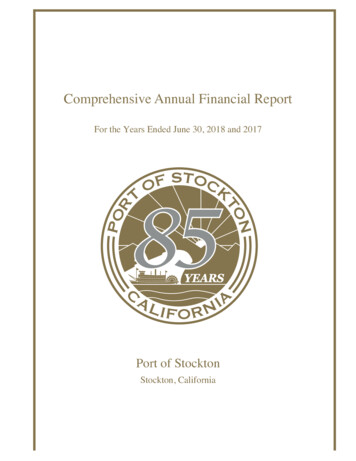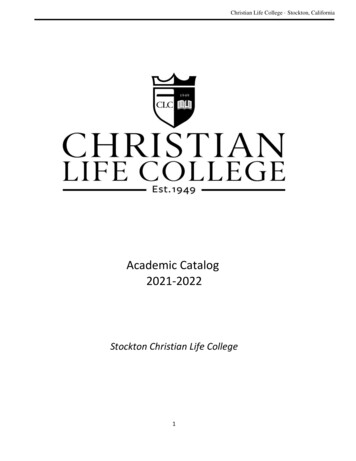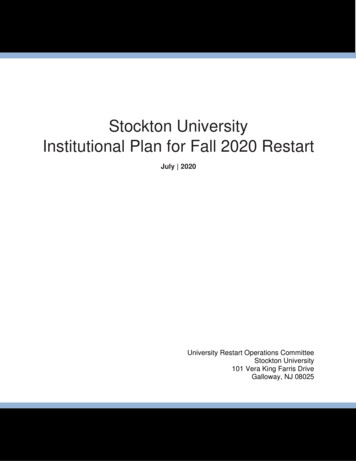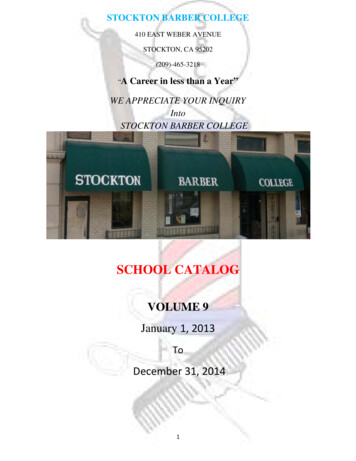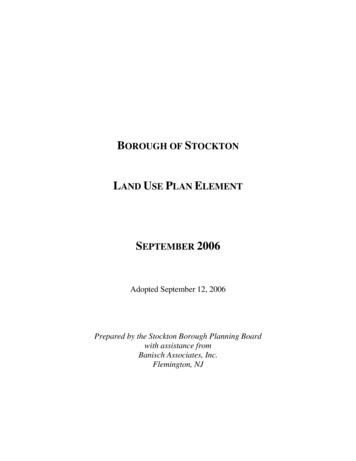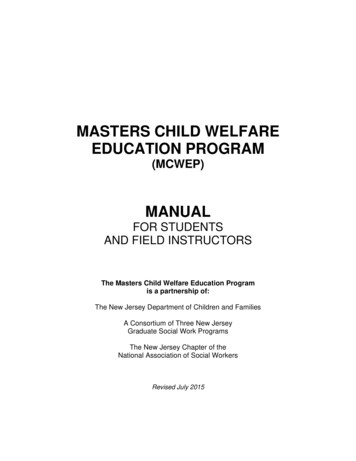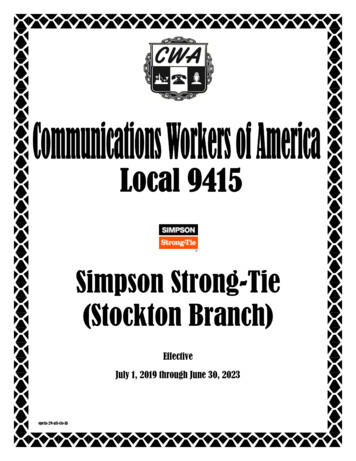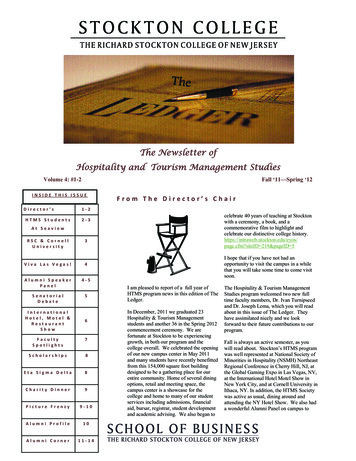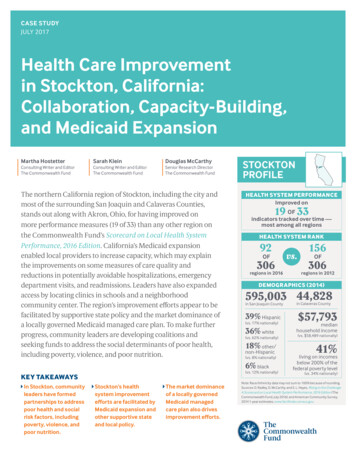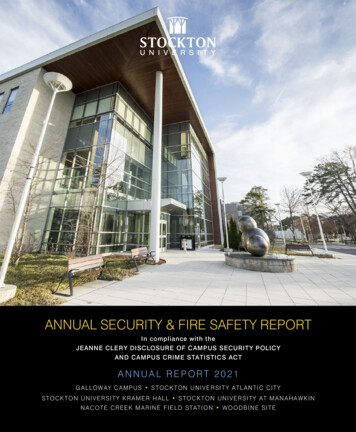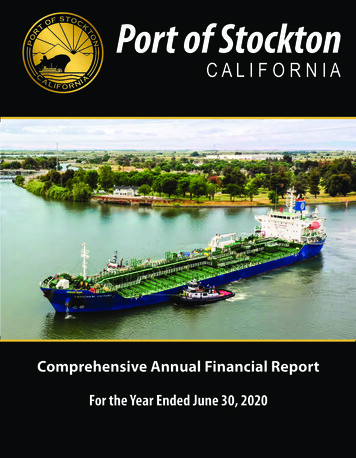
Transcription
Port of StocktonCALIFORNIAComprehensive Annual Financial ReportFor the Year Ended June 30, 2020
Cover Photo:With over 18,000 metric tonnes of food oils destined for the Port, the Fairchem Victory makesher way to Berth 2. Liquid bulk cargoes currently represent more than a quarter of the Port’stonnage, and is expected to show strong growth in the coming years.
Comprehensive Annual Financial ReportFor the Year Ended June 30, 2020Port of StocktonP.O. Box 2089Stockton, CA 95201Prepared byThe Finance Department
Stockton Port DistrictComprehensive Annual Financial ReportTable of ContentsFor the Year Ended June 30, 2020Introductory Section (unaudited):Letter of Transmittal . iGovernment Finance Officers Association (GFOA) Certificate of Achievement for Excellence inFinancial Reporting . vBoard of Port Commissioners and Port Director . viOrganization Chart . viiAerial View of the East and West Complex . viiiFinancial Section:Independent Auditor’s Report . 1Management’s Discussion and Analysis (unaudited Required Supplementary Information) . 4Basic Financial Statements:Statement of Net Position . 12Statement of Revenues, Expenses, and Changes in Net Position . 13Statement of Cash Flows . 14Notes to Financial Statements . 16Required Supplementary Information (unaudited)Schedule of Changes in the Total OPEB Liability and Related Ratios . 34Supplementary InformationOutstanding Construction in Progress Detail . 35Statistical Section (unaudited):Summary of Revenues, Expenses, and Changes in Net Position - 10 years . 37Net Position by Component - 10 years . 39Principal Customers - 2020 . 41Summary of Revenues and Revenue Tonnage Trends - 10 years . 42Computation of Legal Debt Margin - 10 years. 44Ratios of Outstanding Debt by Type - 10 years . 46Revenue Bond Coverage - 10 years . 47Demographic Statistics - 10 years . 48Port of Stockton Employees by Department - 10 years. 49Revenue Tonnages - 10 years . 50Port of Stockton Capital Assets by Asset Type - 10 years . 52
Port of StocktonStockton, CaliforniaIntroductory SectionIntroductory Section
P ORT OF S TOCKTONPhone: (209) 946‐0246Fax: (209) 465‐7244November 30, 2020Mr. Richard AschierisPort DirectorStockton Port DistrictP.O. Box 2089Stockton, CA 95201To Mr. Aschieris, Port Director, Port Commissioners, and Citizens of the Port District:The Comprehensive Annual Financial Report for the Stockton Port District (District), for the year endedJune 30, 2020, as prepared by the Finance Department is hereby submitted for your review. Responsibilityfor both the accuracy of the presented data, the completeness and fairness of the presentation, including alldisclosures, rests with the District’s management. To the best of our knowledge and belief the enclosed datais accurate in all material respects and is reported in a manner designed to fairly present the financialposition and changes in the financial position of the District. All disclosures necessary to enable the readerto gain an understanding of the District’s financial activities have been included. Although the District isnot legally required to prepare the Comprehensive Annual Financial Report, we do so to aid financialinstitutions and our community in their understanding of the District’s activities and its financialcomposition.The Management’s Discussion & Analysis, in the financial section, will give readers an informativeoverview of District operations for the last year. To provide reasonable assurance that the financialstatements are accurate, management has established an internal control framework to compile data for thepreparation of the financial statements and to protect the District from fraud, misuse or loss. As with anysystem, the inherent limitations of the system make it essential that the District review this structure whenopportunities are presented but the cost of a control should not exceed the benefits to be derived. Theobjective of internal controls is to provide reasonable, rather than absolute assurances, that the financialstatements are free of any material misstatements. The District’s internal controls include built-in checksand balances for purchasing and billing, contract approval and routine reporting and reconciliationprocedures for accounts. To management’s knowledge, this financial report is complete, accurate andreliable in all material respect.The District is a self-supporting special district of the State of California. Its entire operations are accountedfor on the accrual basis of accounting in a single proprietary enterprise fund and does not levy any taxes.The District has a comprehensive methodology of internal controls that encompasses the whole accountingprocess and its procedures to assure the most accurate distribution of its financial data. The financial auditwas completed by independent auditors, Eide Bailly, LLP. The auditors provide reasonable assurance thatthe financial data is fairly stated and also review the accounting system and procedures.Post Office Box 2089 Stockton, CA 95201‐2089 E‐mail: portmail@stocktonport.comAdministration Office: 2201 West Washington Street Stockton, CA 95203Web Page: www.portofstockton.comi
Government ProfileThe District was established under the California Harbors and Navigation Code, Sections 6200 through6372. It is governed by a seven-member Board of Commissioners (Board). Four commissioners areappointed by the Stockton City Council and three by the San Joaquin County Board of Supervisors. Theday-to-day administration of District operations is under the direction of the Port Director who is selectedby and serves at the will of the Board. A current organization chart of the District is included in this report.The District’s geographical boundaries are the same as the City of Stockton’s, with the exception of aneight-mile long strip extending one-half mile on either side of the Stockton Ship Channel.The District is a deep-water seaport located seventy-five miles inland from San Francisco, in the agriculturalheartland of California in San Joaquin County. The District owns and operates docks, transit sheds, andwarehouses which are used to load and unload cargo from ships, barges, trucks, and railroads, and to storecargos. Cargos handled by the District include various dry and liquid bulk commodities, general cargos,and project cargos. Some of the commodities handled at the District include steel products, rice, cementand slag, sulfur, gypsum, fertilizers, molasses, coal, edible oils, and ammonia. The District also leases landand warehousing facilities to a number of diverse tenants. District operations are self-supporting and receiveno direct tax subsidies.Budget StructureThe Board of Commissioners adopts a budget for each fiscal year. The District uses an informal system ofbudgetary accounting and control. The budgetary estimates are retained in memorandum form and used forcomparative purposes only. As part of the budget presentation, the District utilizes a five-year forecast forcapital projects to improve long range planning.Economic ConditionLocal EconomyAs is most of the country, San Joaquin County (County) is experiencing extreme hardships as a result ofCOVID-19. The Employment Development Department of California states that the County has a laborforce of 322,100 with a current unemployment rate of 11.9%, which is up from the February 2020unemployment rate of 6.6%, but down from the peak rate in April 2020 of 17.8%. The College of BusinessAdministration at Stanislaus State University (SSU) states that leisure and hospitality services, along withretail employment have been hit the hardest. Because the valley is a farm-related economy, the impact ontrade and transportation, as well as wholesale trade will be lighter. Additionally, construction employment,which was the fastest-growing sector in 2019, will realized a lesser impact as well. SSU predicts thatdemand for housing in the area will increase as Bay Area residents seek a less-hectic and safer lifestyle.SSU also predicts that while the greater San Joaquin Valley’s recovery is expected to be slower than thenationwide rebound, they project an annualized growth of 1.05% in employment from the second half of2020 to the first half of 2021, with normal growth expected by the second half of 2022. The County has apopulation of approximately 773,600 people, which is expected to grow 1.5% in 2020. The current medianannual household income is 53,274.San Joaquin County is one of the largest agricultural producers in the State. The total area in the county is1,391 square miles with 772,762 acres of farmland, according to the 2017 Census. The gross value fromthe county’s agricultural products in 2019 was approximately 2.6 billion, an increase of .9% from 2018.The agricultural production in the county is the byproduct of a fertile land and temperate weather conditions.The County’s top six leading crops are almonds, milk, grapes, walnuts, eggs, and cattle.ii
The County enjoys a highly educated workforce, with many coming from the local colleges in the area. TheUniversity of the Pacific, California State University, Stanislaus-Stockton Center, Humphreys College andHumphreys School of Law, National University and San Joaquin Delta Community College all offer a widechoice of educational opportunities within the community. There are also many adult educational programsavailable throughout the 15 school districts in the County.The District plays an important role in providing local industry and shippers’ access to the internationalexport and import marketplace. Through the District’s facilities, local products are shipped botheconomically and efficiently. Our modern facilities are designed to enhance the shipment of break bulk,general cargoes and bulk cargoes, such as steel products, rice, bulk cement, coal, fertilizers and liquidproducts. The District operates within Foreign Trade Zone #231 and offers its customer the flexibility andadvantages of operating within those regulations.Long-term Financial PlanningThe District is a public entity that functions similar to a self-supporting business. Our long-term planningand financial goals are tied to our customer base and the needs of future customers/tenants. With theconveyance of the adjacent Rough & Ready Island Naval Base in 2000, the District started a developmentprogram for infrastructure improvements that includes the Port of Stockton Expressway Bridge, expandedrail infrastructure, dredging the docks and other amenities for customer usability. Any new developmentsor improvements will be customer driven as they expand their operations or as new businesses come to theDistrict. The District refunded the 1997 bonds and issued 29.7 million in new bonds in 2007. In 2013, theDistrict refunded the 2001 Bonds with an installment loan with Compass Bank and secured capital leasesfor equipment for the terminal and warehouse operations. The District secured an 8.2 million loan for railinfrastructure improvements in fiscal year 2016. In fiscal year 2017, the District refunded the 2007 seriesA (tax-exempt) Bonds and the I-Bank loan while issuing an additional 5 million in bonded debt forinfrastructure projects. The District has a total of 38.3 million in outstanding bonds, loans and capital leaseobligations. The bonds and installment loans are secured by and payable from gross revenues derived fromthe operations of District facilities. The proceeds of these issues were used for capital improvements andrefunding certain outstanding bond issues. The District has no general obligation bonds. The details of ourdebt structure can be reviewed in the Management’s Discussion and Analysis and the Notes to the FinancialStatements.Relevant Financial PoliciesThe Board has established financial policies that affected the financial position in the current year and giveguidelines on cash management and investments, purchasing, and capital expenditures that are followed bythe management staff. Through the budget process each year, the Board reviews and approves the District’sfinancial projections, goals, and business trends. In the budget, there is also a five-year forecast for capitalimprovements and new projects that present our future objectives. For all financial reporting and accountingprocedures, the District uses the Governmental Accounting Standards Board (GASB) guidelines as ourstandard.Major InitiativesThe District received 7.0 million this year in capital grant funds for infrastructure improvements, whichincluded the homeland security projects, electric material handling equipment, the Navy Drive Bridgerehabilitation, the Dock 12/13 rehabilitation, and the Fyffe Avenue grade separation project. These capitalprojects were funded by federal and state grants and district revenues. All of these improvements haveadded value to the District and the community in terms of business opportunities and new jobs. Subsequentto the close of the period the District signed a construction contract for the Substation Transformer Projectin the amount of 1.28 million. This project will be funded with the District’s unrestricted cash.iii
Awards & AcknowledgementsThe Government Finance Officers Association of the United States and Canada (GFOA) awarded aCertificate of Achievement for Excellence in Financial Reporting to the Stockton Port District, for itscomprehensive annual financial report for the fiscal year ended June 30, 2019. This was the twentiethconsecutive year that the Stockton Port District has achieved this prestigious award. In order to be awardeda Certificate of Achievement, a government unit must publish an easily readable and efficiently organizedcomprehensive annual financial report. This report must satisfy both generally accepted accountingprinciples and applicable legal requirements. A Certificate of Achievement is valid for a period of one yearonly. We believe our current comprehensive annual financial report continues to conform to the Certificateof Achievement Program’s requirements and we are submitting it to the GFOA to determine its eligibilityfor another certificate.The preparation of this report could not have been accomplished without the efficient and dedicated servicesof the entire staff of the Finance Department. Thanks and appreciation are also extended to the firm of EideBailly, LLP for their professional approach and high standards in the conduct of their independent audit ofthe report. We would also like to thank the Port Director, Richard Aschieris, and the members of theCommission for their guidance and support throughout the year. We appreciate their interest and supportin planning and conducting the financial operation of the District in a progressive and responsible manner.Respectfully SubmittedMichelle BowlingInterim Director of FinanceEsmeralda CorreaControlleriv
Government Finance Officers AssociationCertificate ofAchievementfor Excellencein FinancialReportingPresented toPort of StocktonCaliforniaFor its Comprehensive AnnualFinancial ReportFor the Fiscal Year EndedJune 30, 2019Executive Director/CEOv
Board of Port Commissioners and Port DirectorGary ChristophersonChairmanR. Jay AllenVice ChairmanAnthony BarkettCommissionerElizabeth BlanchardCommissionerMichael Patrick DuffyCommissionerStephen GriffenCommissionerWilliam R. TrezzaCommissionerRichard AschierisPort Directorvi
Port of StocktonOrganization ChartJune 30, 2020Board of PortCommissionersPort DirectorA. Richard AschierisSenior Deputy PortDirector, Real Estate& Port DevelopmentSteve EscobarAssistant to theDirector/Secretaryto the BoardMelanie RodriguezReal Estate &PropertiesDevelopmentManagerSylvester AguilarEnvironmental& Public AffairsDirectorJeff WingfieldFinance DirectorMichelle BowlingPropertiesManagerDebbie CalliEnvironmental& RegulatoryAffairs ManagerJason CashmanControllerEsmeralda CorreaChief of PoliceRick SalsedoDirector of HumanResources &AdministrativeServicesKatie MillerEmergencyManagement &Safety OfficerJeff VineDirector ofPlanning &Development/DBELO ManagerJuan VillanuevaDirector ntendentSteve CookerlyRicardo NavarroOperationsManagerChris MountjoyInformationTechnologyManagerDavin GarciaMarketingManagerPete GrossgartTelecommManagerRuss NicholasMaritimeAccounts &Tariffs ManagerVacantvii
EASTCOMPLEXviii
WESTCOMPLEXix
This page intentionally left blank.
Financial SectionFinancial SectionPort of StocktonStockton, California
Independent Auditor’s ReportTo the Board of CommissionersStockton Port DistrictStockton, CaliforniaReport on the Financial StatementsWe have audited the accompanying financial statements of the Stockton Port District (District) as of andfor the year ended June 30, 2020, and the related notes to the financial statements, which collectivelycomprise the District’s basic financial statements as listed in the table of contents.Management’s Responsibility for the Financial StatementsManagement is responsible for the preparation and fair presentation of these financial statements inaccordance with accounting principles generally accepted in the United States of America; this includesthe design, implementation, and maintenance of internal control relevant to the preparation and fairpresentation of financial statements that are free from material misstatement, whether due to fraud orerror.Auditor’s ResponsibilityOur responsibility is to express an opinion on these financial statements based on our audit. Weconducted our audit in accordance with auditing standards generally accepted in the United States ofAmerica and the standards applicable to financial audits contained in Government Auditing Standards,issued by the Comptroller General of the United States. Those standards require that we plan andperform the audit to obtain reasonable assurance about whether the financial statements are free frommaterial misstatement.An audit involves performing procedures to obtain audit evidence about the amounts and disclosures inthe financial statements. The procedures selected depend on the auditor’s judgment, including theassessment of the risks of material misstatement of the financial statements, whether due to fraud orerror. In making those risk assessments, the auditor considers internal control relevant to the entity’spreparation and fair presentation of the financial statements in order to design audit procedures thatare appropriate in the circumstances, but not for the purpose of expressing an opinion on theeffectiveness of the entity’s internal control. Accordingly, we express no such opinion. An audit alsoincludes evaluating the appropriateness of accounting policies used and the reasonableness ofsignificant accounting estimates made by management, as well as evaluating the overall presentation ofthe financial statements.We believe that the audit evidence we have obtained is sufficient and appropriate to provide a basis forour audit opinion.What inspires you, inspires us. eidebailly.com2151 River Plaza Dr., Ste. 308 Sacramento, CA 95833-4133 T 916.570.1880 F 916.570.1875 EOE1
OpinionIn our opinion, the financial statements referred to above present fairly, in all material respects, therespective financial position of the District, as of June 30, 2020, and the respective changes in financialposition and cash flows thereof for the year then ended in accordance with accounting principlesgenerally accepted in the United States of America.Other MattersRequired Supplementary InformationAccounting principles generally accepted in the United States of America require that the management’sdiscussion and analysis and schedule of changes in total other postemployment benefits (OPEB) liabilityand related ratios, as listed in the table of contents be presented to supplement the basic financialstatements. Such information, although not a part of the basic financial statements, is required by theGovernmental Accounting Standards Board, who considers it to be an essential part of financialreporting for placing the basic financial statements in an appropriate operational, economic, orhistorical context. We have applied certain limited procedures to the required supplementaryinformation in accordance with auditing standards generally accepted in the United States of America,which consisted of inquiries of management about the methods or preparing the information andcomparing the information for consistency with management’s responses to our inquiries, the basicfinancial statements, and other knowledge we obtained during our audit of the basic financialstatements. We do not express an opinion or provide any assurance on the information because thelimited procedures do not provide us with sufficient evidence to express an opinion or provide anyassurance.Other InformationOur audit was conducted for the purpose of forming opinions on the financial statements thatcollectively comprise the District’s basic financial statements. The introductory section, outstandingconstruction in progress detail, and statistical section are presented for purposes of additional analysisand are not a required part of the basic financial statements.The outstanding construction in progress detail is the responsibility of management and was derivedfrom and relates directly to the underlying accounting and other records used to prepare the basicfinancial statements. Such information has been subjected to the auditing procedures applied in theaudit of the basic financial statements and certain additional procedures, including comparing andreconciling such information directly to the underlying accounting and other records used to preparethe basic financial statements or to the basic financial statements themselves, and other additionalprocedures in accordance with auditing standards generally accepted in the United States of America. Inour opinion, the outstanding construction in progress detail is fairly stated, in all material respects, inrelation to the basic financial statements as a whole.The introductory and statistical sections have not been subjected to the auditing procedures applied inthe audit of the basic financial statements and, accordingly, we do not express an opinion or provide anyassurance on them.2
Other Reporting Required by Government Auditing StandardsIn accordance with Government Auditing Standards, we have also issued our report dated November 30,2020 on our consideration of the District’s internal control over financial reporting and on our tests of itscompliance with certain provisions of laws, regulations, contracts, and grant agreements and othermatters. The purpose of that report is solely to describe the scope of our testing of internal control overfinancial reporting and compliance and the results of that testing, and not to provide an opinion on theeffectiveness of the District’s internal control over financial reporting or on compliance. That report isan integral part of an audit performed in accordance with Government Auditing Standards in consideringthe District’s internal control over financial reporting and compliance.Sacramento, CaliforniaNovember 30, 20203
STOCKTON PORT DISTRICTMANAGEMENT’S DISCUSSION AND ANALYSISManagement’s Discussion and Analysis(Unaudited)The management’s discussion and analysis (MD&A) of the Stockton Port District’s (District) financialperformance provides an overview of the District’s financial activities for the year ended June 30, 2020.We encourage readers to consider the information presented here in conjunction with additional informationthat we have furnished in our Letter of Transmittal, which can be found on pages i-iv of this report.DISTRICT HIGHLIGHTSThe District’s unrestricted cash and investments increased by 392 thousand from 2019 due to timing ofpayments.The District invested 16.5 million in ongoing infrastructure improvement projects and other capital assetsto enhance the resources available at the District’s facilities. The District utilized federal and state grants,and District revenues to finance the capital expenditures.Port waterborne tonnages decreased 15% from last year. Steel imports decreased as a result of Section 232tariffs on steel. Cement/slag tonnages decreased due to increased tariffs on Chinese cement. Other dry bulkcommodities decreased as well with liquid bulk commodities increasing by 9%.The District utilized 7 million in federal and state grant funds in the last fiscal year from previouslyawarded grant programs for the Navy Drive bridge replacement, Fyffe Avenue grade separation project,the acquisition of electric material handling equipment, and other security projects.Overview of the Financial StatementsThe District is a special municipal district created through the State of California Harbors & NavigationCode. The District is an enterprise fund. It has no other funds and receives no tax dollars. The District, forreference purposes, is described by two locations that are divided by water. The “East Complex” is theoriginal District property and the “West Complex” is property on Rough and Ready Island located west ofthe initial District property.The MD&A serves as an introduction to the District’s basic financial statements. The District is responsiblefor its content and accuracy. It summarizes the financial data, key financial and operational activities andwill aid in the reader’s understanding of the District’s financial position and performance. The District’sbasic financial statements consist of the financial statements and notes to the financial statements. Thisreport also includes supplemental information intended to furnish additional detail to support the basicfinancial statements themselves.Accounting methods and financial statements used are similar to those in the private sector. The statementof net position feature assets, deferred outflows of resources, liabilities, deferred inflows of resources, andnet position information. The statement of revenues, expenses, and changes in net position define therevenue and expense sources that fund the overall success of the District. The statement of cash flowspresent information on District activities and its effect on cash reserves. The notes to financial statementsprovide additional information that is essential to understanding the data provided in the basic financialstatements. The information in the required supplementary information sections features additional detailsfor the better understanding of certain financial data as listed in the table of contents. In addition to the vitalfinancial statements and notes, this report also contains historical information about the District. This willgive readers a broader understanding of the District’s history. The following discussion and analysisprovides an overview of the District’s financial activities.4
STOCKTON PORT DISTRICTMANAGEMENT’S DISCUSSION AND ANALYSISFinancial AnalysisStatements of Net PositionThe statement of net position presents the financial position of the District at the end of the fiscal year. Thestatement includes all assets, deferred outflows of resources, liabilities, and the deferred inflows ofresources of the District. Net position, the difference between total assets and deferred outflows of resourcesand total liabilities and deferred inflows of resources, and its changes are a reflection of the overall healthand future of the District. A summarized comparison of the District’s assets, deferred outflows and inflowsof resources, liabilities, and net position as of June 30, 2020 and 2019 are as follows:Statements of Net Position(in thousands)Current and Other AssetsCapital Assets, Net of DepreciationTotal AssetsDeferred Outflows of Resources - Loss on RefundingDeferred Outflows of Resources - OPEBTotal Deferred OutflowsLong-term LiabilitiesOther LiabilitiesTotal LiabilitiesDeferred Inflows of Resources -
PORT OF STOCKTON Phone: (209) 946‐0246 Fax: (209) 465‐7244 Post Office Box 2089 Stockton, CA 95201‐2089 E‐mail: portmail@stocktonport.com Administration Office: 2201 West Washington Street Stockton, CA 95203 Web Page: www.portofstockton.com
